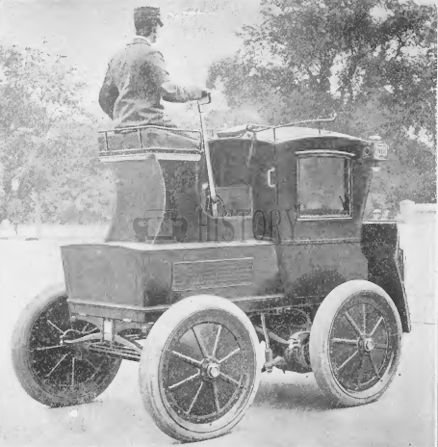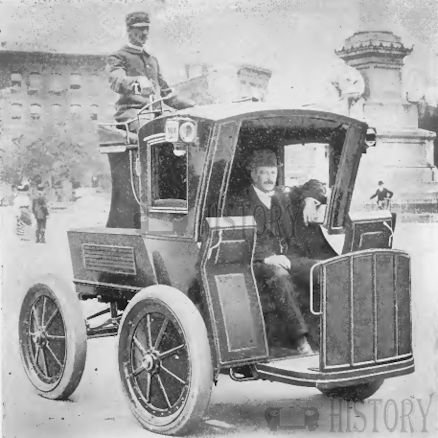EVC Hansom (Electric Vehicle Company)
The Electric Vehicle Company (EVC) was a manufacturer of electric-powered taxis and at the end of the 19th century, the largest automobile manufacturer of the United States . The company was reorganized in 1897 as a holding company and then served as a vehicle for the (failed) construction of taxi monopolies in major cities. In the context of opaque financial transactions and as a legal entity for the Selden patent , the company was increasingly criticized. Between 1901 and 1909, the EVC was the legal successor to the Columbia Automobile Company and thus manufacturer of the Columbiaand Columbia Electric vehicles. After that, the name was given up. Said vehicles were manufactured until 1913 at the successor Columbia Motor Car Company .
Company History
The German-born inventor and entrepreneur Isaac L. Rice (1850-1915) had founded in 1888, the Electric Storage Battery Company (ESB), based at the junction of 19th Street and Allegheny Avenue in Philadelphia and the market leader for stationary batteries. The establishment of the Electric Vehicle Company (EVC) on September 27, 1897, around the same time as the Electric Boat Company, was his next logical step, as the electric vehicles produced here were typical users of such batteries. The Electric Vehicle Company specialized in reliable motorized taxi cabs with electric drive . road brand vehicles Electric Vehicle was available from 1897 to 1899.
Already in May 1897 the takeover of the Electric Carriage & Wagon Company (ECWC) took place in New York. Their designers Henry G. Morris and Pedro G. Salom had built in 1893 with the Morris & Salom Electrobat I, the first truly usable electric car. Morris and Salom were not employed exclusively by ECVC and continued to build electric vehicles in their other operations, the Morris & Salom Electric Company . The designer Hiram Percy Maxim (1869-1936) was chief engineer of the Columbia Automobile Company .
The range of such vehicles was initially little more than 30 kilometers, which limited the meaningful use on urban areas and made a dense network of stations required. The pioneering work to had formed as recently as January 1896 ECVC done, which had developed a rental system, their vehicles but also sold. Morris and Salom were convinced that the required technical understanding of the operation and maintenance of vehicles could not be assumed by private customers.
Hansom Cabs
The first generation of EVC electric taxis was carved as Hansom Cabs . Originally developed for (rental) horse-drawn carriages, this design was occasionally used in the early days of automobiles on motor vehicles and in particular power cabs . In the Hansom , the passengers sit in a closed compartment, the driver or driver has his unprotected from the weather seat behind, high above the roof of the vehicle. Depending on the model, access to the passenger compartment is provided from the side or via a double-wing door from the front.
At EVC , taxi drivers and private customers were no longer able to buy the vehicles, but only rent them. The idea was taken over by the concept of rented stables and relay stations, which was well known to the customers and which lent horses and teams in this way. The individually negotiated contracts also regulated maintenance and loading costs and also simplified the training of drivers. EVC set up a network of service stations in several cities where this work was carried out and above all the battery packs were replaced.
Between 1897 and 1899, several hundred EVC vehicles were manufactured; in Manhattan alone several dozen were in operation.
The purchase of the Electric Carriage & Wagon Company (ECWC) on 9 May 1899 necessitated a new reorganization. This company was capitalized at US $ 5 million. He was joined by the EVC production department, the Electric Storage Battery Company with a valuable patent on batteries, and the Pope car factories. President of the company was George Day, Vice President Harold Hayden Eames . The EVC as the operator of the electric taxis bought the entire corresponding production of the ECWC. The concept of financial links of taxi operators and manufacturers have lasted very long.
The former EVC production facility in New York was no longer needed. The successor to the EVC now came from the Pope factory in Hartford (Connecticut) and were used as Columbia markets what's new Columbia made it the market leader in the US auto industry, with a market share of nearly 50 percent.The actual goal, the control of the taxi market, could not be achieved by the strengthened Lead Cab Trust .
1901 was a reorganization. Temporarily, the Columbia Automobile Company was not run as a company but as a department of the EVC . The established brand names Columbia and Columbia Electric and, possibly, for a short time, Riker Electric have survived. Hiram Maxim left the company at that time to work on the development of a silencer for firearms; later he adapted the principle also for exhaust systems and industrial uses.
From 1907 to 1908 there was a misleading "Magnetic" called car with gasoline electric hybrid drive .
In August 1907, Managing Director MJ Budlong resigned. In December 1907, the EVC had to file for bankruptcy with debts amounting to US $ 3.5 million. The insolvency itself, with unforeseeable consequences for the Selden process, could be averted, however. The company recovered somewhat, but remained weak. 1908 broke Popes empire together. 1909 was a reorganization of the EVC and renamed the Columbia Motor Car Company .
1909 won the ALAM - and thus the Columbia Motor Car Company group of companies, which was set up on the model of General Motors and was chronically underfunded, went bankrupt in 1912 with around twelve affiliated brands, with spectacular consequences for the confidence in the young auto industry. The Columbia Motor Car Companyclosed in 1913 and the sole remaining subsidiary of the United States Motor Company , the Maxwell Motor Company , became the nucleus of the Chrysler Corporation.
Baker Torpedo Kid
In 1902, the Electric Vehicle Company built an electric racing car for its competitor Baker Electric . The vehicle was designed by Walter C. Baker and showed similarities with an earlier Jeantaud design. It received an electric motor from Elwell-Parker with 12 hp at that time calculation and a streamlined body which reminded of a submarine . The vehicle is one of the first examples of the implementation of aerodynamic principles in the automotive industry and also according to unproven statements, the first car with a safety belt .


